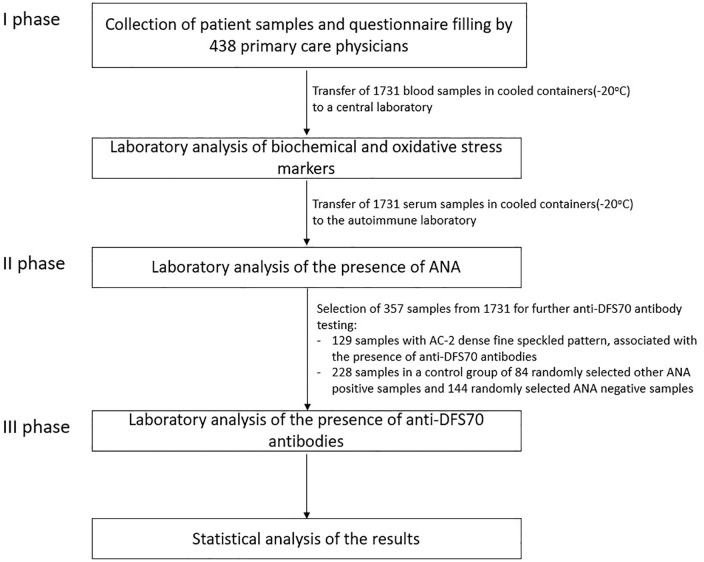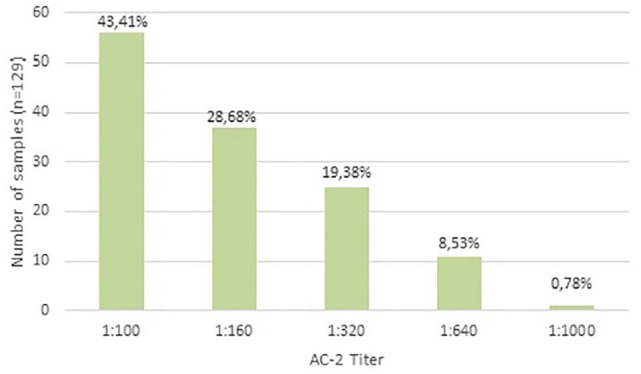抗dfs70自身抗体与氧化应激的关系
IF 2.6
Q2 MEDICINE, RESEARCH & EXPERIMENTAL
引用次数: 1
摘要
背景:抗dfs70自身抗体是最常见和广泛描述的临床意义未知的药物之一,经常在健康个体中检测到。目前尚不清楚DFS70自身抗体是保护性的还是致病性的。被怀疑诱导形成抗dfs70抗体的因素之一是氧化应激的增加。我们评估了抗dfs70抗体与氧化应激标记物的共存情况,并研究了这些抗体是否可以被视为氧化应激的间接标记物。方法:通过总氧化状态(TOS)、脂质氢过氧化物(LPH)、脂褐素(LPS)和丙二醛(MDA)浓度等自由基对脂质和蛋白质的损伤指数来测量所有样品的氧化应激强度。测定了非酶促抗氧化系统的总抗氧化状态(TAS)、尿酸浓度(UA)及超氧化物歧化酶(SOD)活性。根据TOS和TAS值计算氧化应激指数(OSI)。所有样品均采用间接免疫荧光法(IFA)检测,并选择357份样品进行直接单特异性抗DFS70酶联免疫吸附法(ELISA)检测。结果:21.29%的样品经ELISA检测,检测出dfs70抗体。与抗dfs70阴性样品相比,LPH浓度降低23% (P = 0.038), UA浓度降低11% (P = 0.005)。TOS降低20% (P = 0.014)。SOD活性比对照组高5% (P = 0.037)。Pearson相关性显示LPH、UA和TOS呈弱负相关,SOD活性呈弱正相关。结论:在抗dfs70抗体阳性的样品中,氧化应激水平下降,特别是在抗体滴度高的样品中。抗dfs70抗体可以被认为是氧化应激降低的间接标记物或表明近期抗氧化过程增强的标记物。本文章由计算机程序翻译,如有差异,请以英文原文为准。



Relationship Between Anti-DFS70 Autoantibodies and Oxidative Stress.
Background: The anti-DFS70 autoantibodies are one of the most commonly and widely described agent of unknown clinical significance, frequently detected in healthy individuals. It is not known whether the DFS70 autoantibodies are protective or pathogenic. One of the factors suspected of inducing the formation of anti-DFS70 antibodies is increased oxidative stress. We evaluated the coexistence of anti-DFS70 antibodies with selected markers of oxidative stress and investigated whether these antibodies could be considered as indirect markers of oxidative stress. Methods: The intensity of oxidative stress was measured in all samples via indices of free-radical damage to lipids and proteins such as total oxidant status (TOS), concentrations of lipid hydroperoxides (LPH), lipofuscin (LPS), and malondialdehyde (MDA). The parameters of the non-enzymatic antioxidant system, such as total antioxidant status (TAS) and uric acid concentration (UA), were also measured, as well as the activity of superoxide dismutase (SOD). Based on TOS and TAS values, the oxidative stress index (OSI) was calculated. All samples were also tested with indirect immunofluorescence assay (IFA) and 357 samples were selected for direct monospecific anti DFS70 enzyme-linked immunosorbent assay (ELISA) testing. Results: The anti-DFS70 antibodies were confirmed by ELISA test in 21.29% of samples. Compared with anti-DFS70 negative samples we observed 23% lower concentration of LPH (P = .038) and 11% lower concentration of UA (P = .005). TOS was 20% lower (P = .014). The activity of SOD was up to 5% higher (P = .037). The Pearson correlation showed weak negative correlation for LPH, UA, and TOS and a weak positive correlation for SOD activity. Conclusion: In samples positive for the anti-DFS70 antibody a decreased level of oxidative stress was observed, especially in the case of samples with a high antibody titer. Anti-DFS70 antibodies can be considered as an indirect marker of reduced oxidative stress or a marker indicating the recent intensification of antioxidant processes.
求助全文
通过发布文献求助,成功后即可免费获取论文全文。
去求助
来源期刊

Biomarker Insights
MEDICINE, RESEARCH & EXPERIMENTAL-
CiteScore
6.00
自引率
0.00%
发文量
26
审稿时长
8 weeks
期刊介绍:
An open access, peer reviewed electronic journal that covers all aspects of biomarker research and clinical applications.
 求助内容:
求助内容: 应助结果提醒方式:
应助结果提醒方式:


